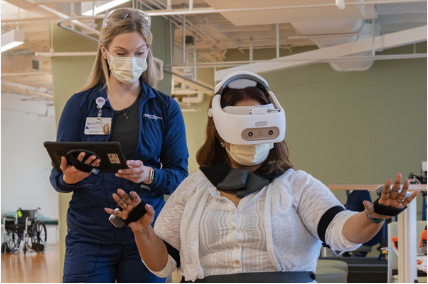Blood Flow Restriction Training in Rehabilitation
For blood flow restriction (BFR) training, a physical therapist will use equipment to block blood from flowing to an arm or leg. They may block all blood flow or just partially block it. The physical therapist will do this during exercises to help you heal and get stronger.
To learn more or schedule a visit, please call 630.933.1500. Online scheduling options are also available.

How It Works
Muscles grow and get stronger when:
- Stress, such as lifting weights, injures the muscles fibers, causing your body to repair them.
- Less oxygen is available for your muscles, helping your body find ways to work without it.
- Muscle cells swell because more blood flows into your muscles.
Restricting your blood flow speeds up the process of your muscles swelling, getting tired and using up oxygen. BFR training can:
- Speed up recovery.
- Strengthen the muscles in your affected limb.
- Help you achieve better outcomes.
Your therapist will customize BFR training based on the affected limb and how much pressure they can safely apply. You will wear a cuff that will tighten to restrict blood flow. Most people feel some discomfort but no pain. The cuff will connect to a smart tablet via Bluetooth. Your physical therapist will use the tablet to monitor and adjust the restriction.
Physical therapists can use BFR training in a typical session. Most patients who get this type of treatment receive it in the early or middle stages of your rehabilitation journey.
A physician may recommend BFR Training, but your physical therapist will determine if it is appropriate based on your condition.
Who May Benefit From BFR Training
This treatment may help during physical therapy for many different issues, including:
- Foot and ankle injuries
- Hip injuries
- Knee injuries
- Shoulder injuries
- Leg fractures
- Arm fractures
- Foot and ankle fractures
- Sprains and strains
- Anterior cruciate ligament (ACL) reconstruction
- Medial collateral ligament reconstruction
- Posterior cruciate ligament reconstruction
- Medial patellofemoral ligament repair
- Quadriceps tendon repair
- Hamstring repair
- Knee meniscectomy
- Knee meniscal repair
- Quad tendon or patellar tendon repairs
- Hip labral repair
- Hip arthroscopy
- Knee arthroscopy
- Rotator cuff repair
- Shoulder labral repair
- Achilles tendon repair
- Tendinopathy

